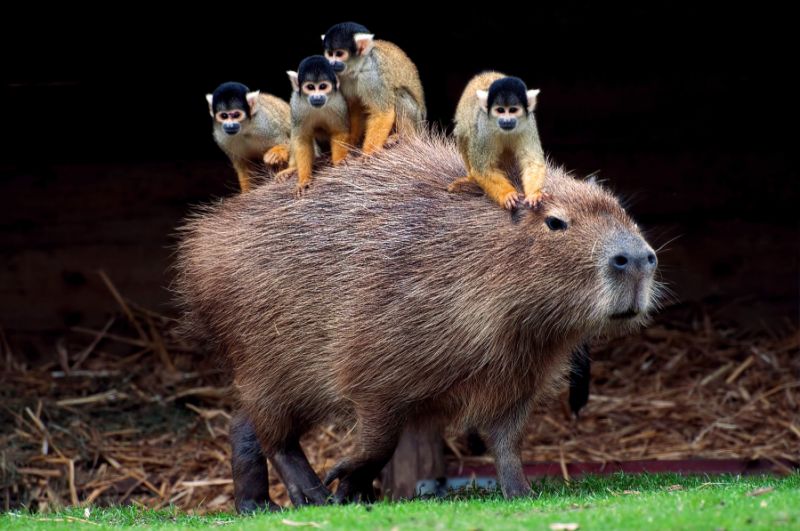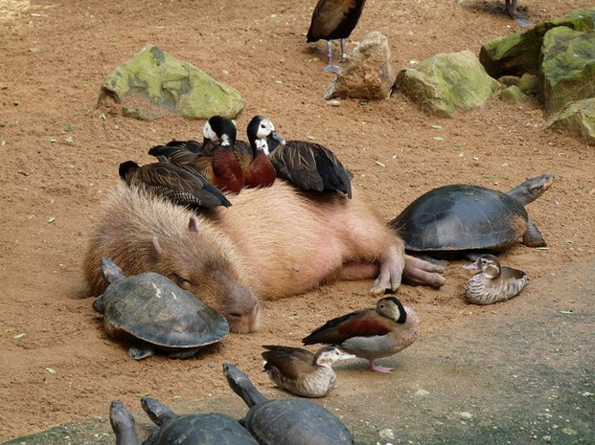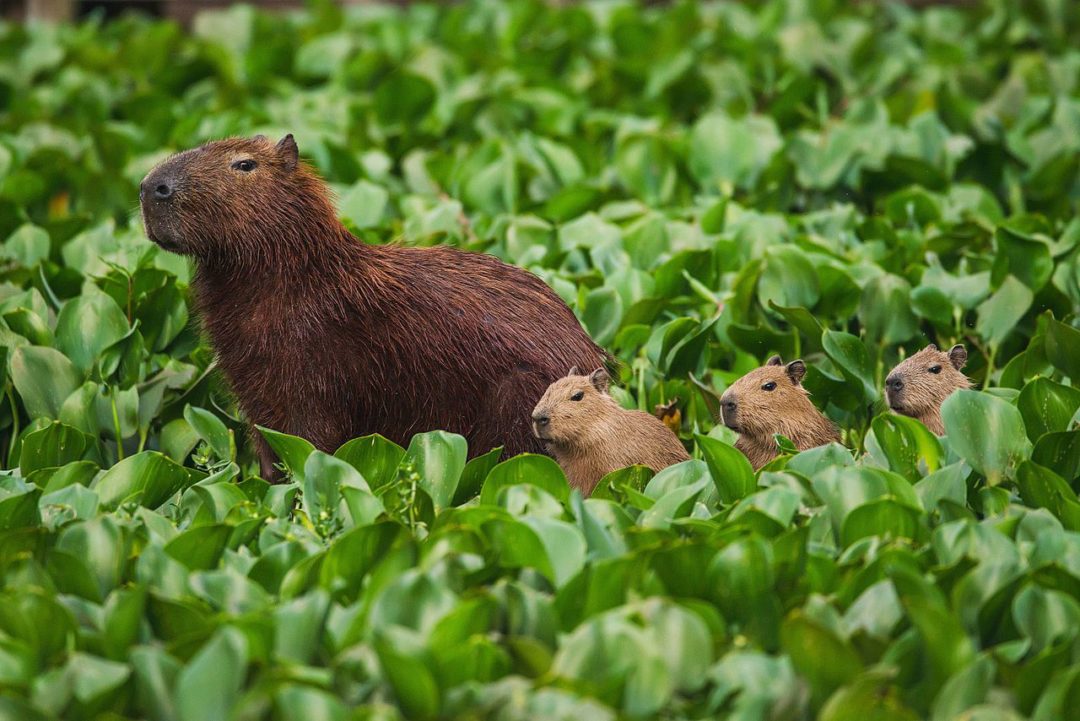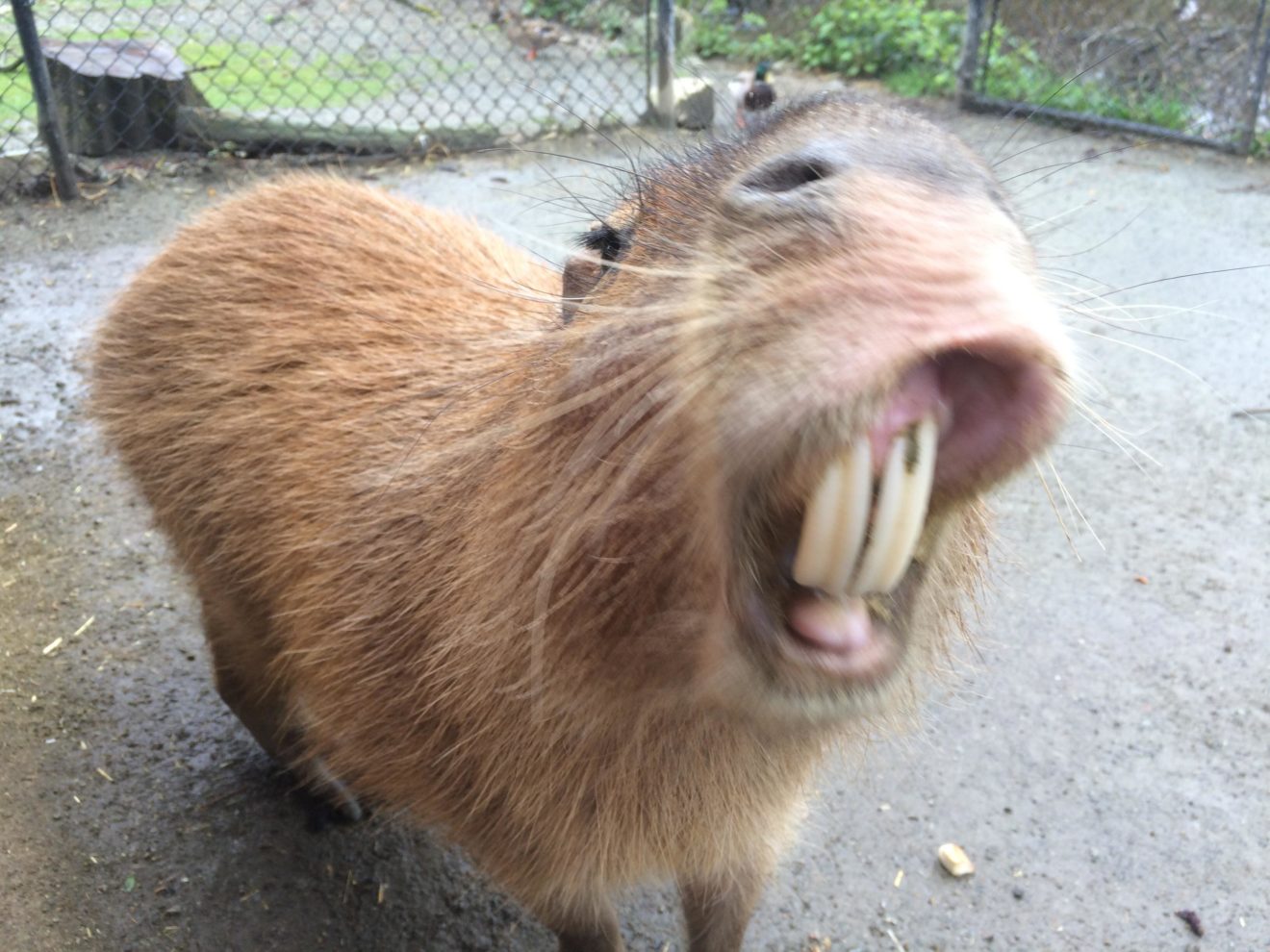‘Watrush.’ Widely known as capybara but the people of Guyana exhaust the name watrush when they see one. The capybara is the largest rodent in the entire world; it is seen along the sandy banks of Rupununi River during the dry season. From a distance they resemble an overgrown guinea pig. In fact, its close relatives include guinea pigs and rock cavies, and it is more distantly related to the agouti, the chinchilla, and the coypu.

Cheeky monkeys hitch a ride on giant rodent | https://www.yahoo.com/news/cheeky-monkeys-hitch-a-ride-on-giant-rodent.html
Scientific Classification Of The Capybara
Capybara – Hydrochoerus hydrochaeris [Scientific name]
- Kingdom: Animalia
- Phylum: Chordata
- Class: Mammalia
- Order: Rodentia
- Family: Caviidae
- Genus: Hydrochoerus
- Species: H. hydrochaeris
Description And Growth Of The Capybara
- Body – The capybara has a heavy, barrel-shaped body and short head, with reddish-brown fur on the upper part of its body that turns yellowish-brown underneath. Its sweat glands can be found in the surface of the hairy portions of its skin, an unusual trait among rodents.
- Hair – The animal lacks down hair, and its guard hair differs little from over hair. When fully grown, a capybara will have coarse hair that is sparsely spread over their skin, making them prone to sunburn. To prevent this, they may roll in mud to protect their skin from the sun.
- Feet and Tail – Capybaras have slightly webbed feet and vestigial tails. Their hind legs are slightly longer than their forelegs; they have three toes on their rear feet and four toes on their front feet.
- Muzzle – Their muzzles are blunt, with nostrils, and the eyes and ears are near the top of their heads.
- Jaw – The capybara’s jaw hinge is non-perpendicular and they thus chew food by grinding back and forth rather than side-to-side.
- Teeth – As is the case with other rodents, the front teeth of capybaras grow continually to compensate for the constant wear from eating grasses; their cheek teeth also grow continuously.
- Growth – Adult capybaras grow to 106 to 134 cm (3.48 to 4.40 ft) in length, stand 50 to 62 cm (20 to 24 in) tall at the withers, and typically weigh 35 to 66 kg (77 to 146 lb). Females are slightly heavier than males. The top recorded weights are 91 kg (201 lb) for a wild female and 73.5 kg (162 lb) for a wild male.

They are super friendly – taking a nap with a literal dozen turtles and ducks | https://www.aol.com/article/news/2016/03/31/why-do-capybaras-get-along-so-well-with-literally-every-other-sp/21336403/
Habitat Of The Capybara
Capybaras are semiaquatic mammals found throughout almost all countries of South America (Guyana) except Chile. They live in densely forested areas near bodies of water, such as lakes, rivers, swamps, ponds, and marshes, as well as flooded savannah and along rivers in the tropical rainforest. They are superb swimmers and can hold their breath underwater for up to five minutes at a time. Capybara have flourished in cattle ranches. They roam in home ranges averaging 10 hectares (25 acres) in high-density populations.
Diet Of The Capybara
Capybaras are herbivores, grazing mainly on grasses and aquatic plants, as well as fruit and tree bark. They are very selective feeders and feed on the leaves of one species and disregard other species surrounding it. They eat a greater variety of plants during the dry season, as fewer plants are available. While they eat grass during the wet season, they have to switch to more abundant reeds during the dry season. Plants that capybaras eat during the summer lose their nutritional value in the winter, so they are not consumed at that time.
Did You Know?
Capybaras are coprophagous, meaning they eat their own feces as a source of bacterial gut flora, to help digest the cellulose in the grass that forms their normal diet, and to extract the maximum protein and vitamins from their food. They may also regurgitate food to masticate again, similar to cud-chewing by a cow.
Reproduction Of The Capybara
During mating, the female has the advantage and mating choice. When in estrus, the female’s scent changes subtly and nearby males begin pursuit. A female alerts males she is in estrus by whistling through her nose. Capybaras mate only in water, and if a female does not want to mate with a certain male, she either submerges or leaves the water. Dominant males are highly protective of the females, but they usually cannot prevent some of the subordinates from copulating. The larger the group, the harder it is for the male to watch all the females.
Gestation – Capybara gestation is 130–150 days, and produces a litter of four capybara young on average, but may produce between one and eight in a single litter. Birth is on land and the female rejoins the group within a few hours of delivering the newborn capybaras, which join the group as soon as they are mobile. Within a week, the young can eat grass, but continue to suckle—from any female in the group—until weaned around 16 weeks. The young form a group within the main group.

Capybara And It’s Young – https://upload.wikimedia.org/wikipedia/commons
Tips:
- Capybaras can make dog-like barks when threatened or when females are herding young.
- They can have a lifespan of 8–10 years, but live less than four years in the wild, because they are “a favorite food of jaguar, puma, ocelot, eagle, and caiman”. The capybara is also the preferred prey of the anaconda.
- They are excellent swimmers, and their ability to remain completely submerged for up to five minutes is useful to evade predators.
- Capybaras can sleep in water, keeping only their noses out of the water.
Capybara In Guyana
These adorable animals are seen in Guyana – mainly in the Rupununi – they are commonly found in groups of around 10 to 20 individuals with 2 to 4 adult males, 4 to 7 adult females and the remainder juveniles. They are not a threatened species but are hunted for their meat and hide and also for grease from its thick fatty skin, which is used in the pharmaceutical trade. Their skin is also said to be great for making high quality leather. Yes, capybaras are indeed fun and interesting rodents found in the Rupununi of Guyana!
Article References
- https://en.wikipedia.org/wiki/Capybara
- http://www.landofsixpeoples.com/news701/nk07031110.html
- https://www.aol.com/article/news/2016/03/31/why-do-capybaras-get-along-so-well-with-literally-every-other-sp/21336403/
Discover more from Things Guyana
Subscribe to get the latest posts sent to your email.







